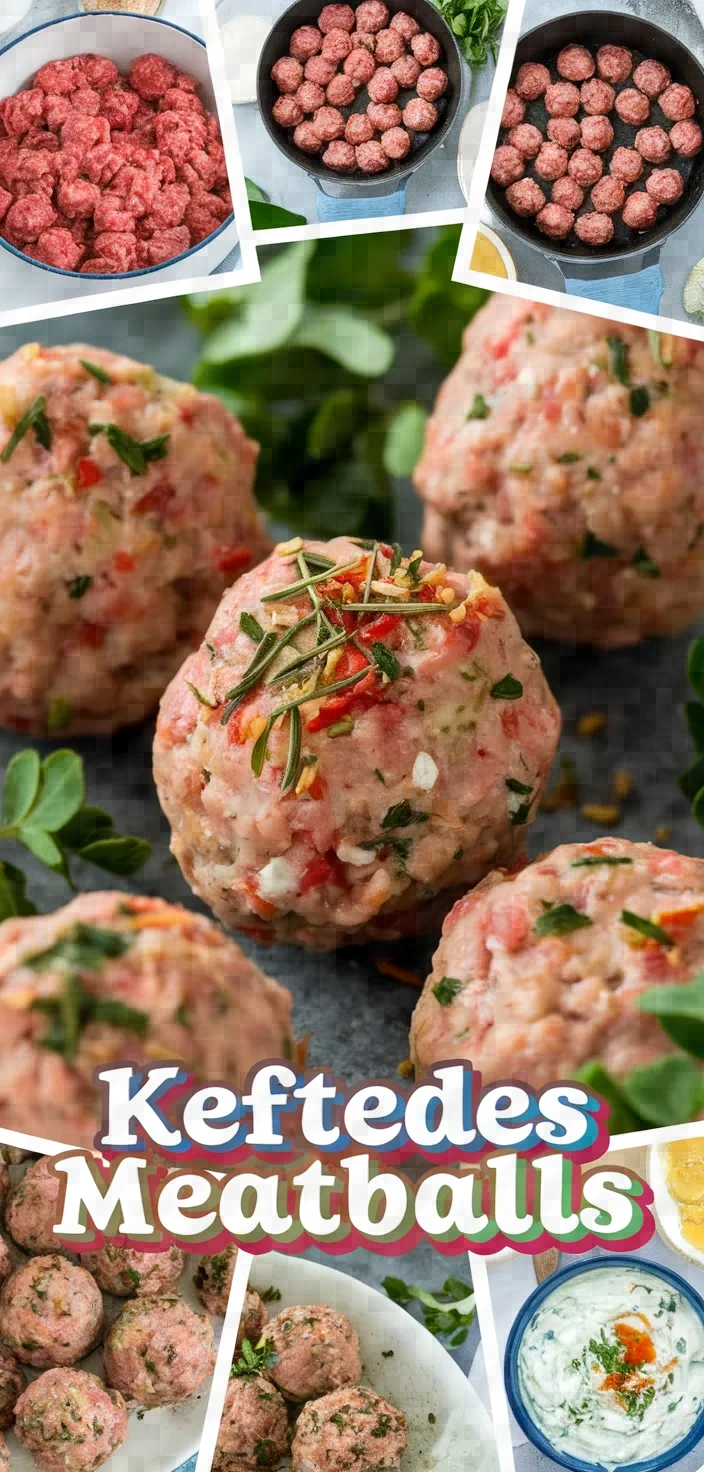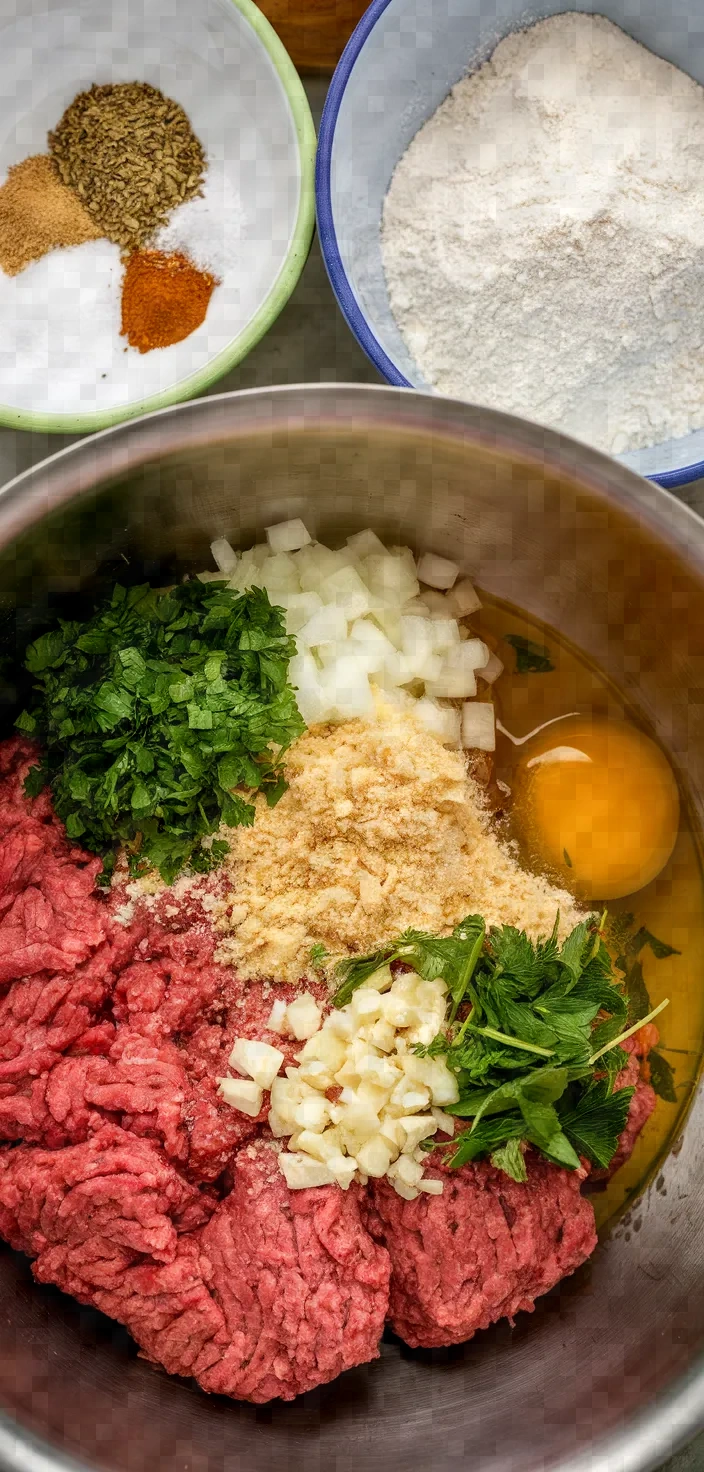Exploring the vibrant flavors of these keftedes takes me back to summer evenings, where the aroma of mint and oregano filled the air while sizzling meatballs browned to perfection. Creating these delectable bites was both a nostalgic journey and a rewarding culinary adventure, as the subtle warmth of cinnamon and cumin combined with fresh herbs to deliver an irresistibly savory experience.

I love making flavors in my kitchen, and Keftedes Greek Meatballs are a favorite. They combine juicy ground beef with aromatic herbs like fresh mint and parsley, and have a delightfully good aromatic quality.
There’s also a shredded onion and a hint of cinnamon in there that make for a remarkably balanced and hearty dish.
Keftedes Greek Meatballs Recipe Ingredients

- Ground Beef: Rich in protein, provides a savory base.
- Onion: Adds sweetness, enhances flavor complexity.
- Garlic: Boosts flavor, offers health benefits.
- Breadcrumbs: Adds texture, helps bind ingredients.
- Fresh Parsley: Adds freshness, contains vitamins.
- Fresh Mint: Brightens flavor, aids digestion.
- Egg: Acts as a binder, adds moisture.
- Olive Oil: Provides healthy fats, used for frying.
- Dried Oregano: Adds earthy, warm notes.
Keftedes Greek Meatballs Recipe Ingredient Quantities
- 1 lb ground beef
- 1 small onion, finely chopped
- 2 cloves garlic, minced
- 1/2 cup breadcrumbs
- 1/4 cup fresh parsley, chopped
- 1/4 cup fresh mint, chopped
- 1 egg
- 1 tbsp olive oil
- 1 tsp dried oregano
- 1 tsp salt
- 1/2 tsp black pepper
- 1/4 tsp ground cinnamon
- 1/4 tsp ground cumin
- Flour, for dusting
- Olive oil, for frying
How to Make this Keftedes Greek Meatballs Recipe
1. In a large bowl, combine the following ingredients for the meat mixture:
• Ground beef
• Finely chopped onion
• Minced garlic
• Breadcrumbs
• Chopped parsley
• Chopped mint
• 1 egg
• 1 tablespoon olive oil
• Dried oregano
• Salt
• Black pepper
• Ground cinnamon
• Ground cumin
2. Combine the components well until they are melded together, and ensure that the herbs and spices are evenly distributed. It’s important to mix thoroughly; the meat must be combined with the juices and the herbs with the meat.
3. Place the bowl in the refrigerator for a minimum of half an hour so that the tastes can come together. This also allows the mixture to set, ensuring it has the correct firmness when you go to bake the cookies.
4. Chill the mixture in the refrigerator. When minimum temperature is reached and mixture is set, remove from the refrigerator. With hands that are just slightly wet, mold the mixture, now set, into small balls. Each should be about the same size as a walnut.
5. Evenly coat each meatball with a light dusting of flour. Ensure that they are nicely coated, but shake off any excess.
6. In a big frying pan, add a plentiful amount of olive oil and bring it to a medium heat, letting it get warm and then shimmer.
7. Add the meatballs to the hot oil carefully, cooking in batches if necessary to avoid overcrowding the pan.
8. Brown the meatballs in a skillet, turning them occasionally so that they brown evenly. They should be fully cooked and browned on all sides in about 8 to 10 minutes.
9. When they are done cooking, take the meatballs out of the skillet and put them on a plate lined with paper towels to soak up any leftover oil.
10. Keftedes can be enjoyed at any time of day, but they are especially nice as an appetizer or part of a meze platter served with olives, dip, Greek yogurt, and grilled or roasted vegetables. For a fun and filling main course, try serving them with pasta drizzled with olive oil and lemon. You could also plate them alongside more Greek dips, with a bowl of tzatziki to spoon over the keftedes. Alternatively, they are fabulous in a pita stuffed with more greens, fresh vegetables, and another round of tahini or tzatziki.
Keftedes Greek Meatballs Recipe Equipment Needed
1. Large bowl
2. Measuring cups and spoons
3. Knife
4. Cutting board
5. Garlic press or mincer
6. Spatula or wooden spoon
7. Refrigerator
8. Plate
9. Paper towels
10. Frying pan or skillet
11. Tongs or slotted spoon
12. Plate or tray for flouring
13. Kitchen timer (optional)
FAQ
- Q: Can I use a different type of meat for the keftedes?A: Yes, ground lamb or a combination of beef and lamb work well and are traditional choices for keftedes.
- Q: Is there an alternative to breadcrumbs for a gluten-free version?A: Gluten-free breadcrumbs or almond flour can serve as substitutes for regular breadcrumbs.
- Q: Can I bake the meatballs instead of frying them?Yes, you can bake the meatballs at 375°F (190°C) for approximately 20 minutes or until they are fully cooked.
- Q: How do I keep the meatballs from falling apart?A: Be certain to mix the ingredients completely and shun mixing too much, which can make the meatballs tough. It can also help if you chill the mixture for 30 minutes before forming the meatballs.
- Q: Can I prepare the mixture in advance?Absolutely! It is possible to ready the blend as much as 24 hours prior and have it waiting in the refrigerator, covered. This should not affect the quality of the blend in any way.
- Q: What can I serve with keftedes?Keftedes is traditional with tzatziki sauce, a Greek salad, or rice pilaf.
- Q: How can I store leftovers?Cooked keftedes can be kept in an airtight container in the fridge for 3 days or frozen for 2 months.
Whether thawed or not, reheating instructions are as follows:
Heat olive oil in a skillet over medium heat until shimmering.
Keftedes Greek Meatballs Recipe Substitutions and Variations
Substitutes for ground beef include ground turkey or lamb.
Regular breadcrumbs can be substituted with Panko breadcrumbs for another texture.
Dried parsley or mint may be used in the absence of fresh herbs, but use less of them, as they are more potent.
If you don’t have fresh garlic, you can substitute each clove with 1/4 teaspoon of garlic powder.
You can use alternative flours, like almond or rice flour, to dust surfaces and keep the recipe gluten-free.
Pro Tips
1. Resting the Mixture: Allowing the meat mixture to chill and rest in the refrigerator not only helps the flavors meld but also makes the mixture firmer, making it easier to form into meatballs that hold their shape while cooking.
2. Uniform Size: When forming the meatballs, it’s helpful to use a small ice cream scoop or spoon to ensure uniform size. This ensures even cooking, as all the meatballs will cook at the same rate.
3. Prevent Stickiness: Slightly wetting your hands before shaping the meatballs can help prevent the mixture from sticking to your hands, making the process smoother and cleaner.
4. Oil Temperature: Ensure the oil is hot enough before adding the meatballs. A small piece of the mixture can be used as a test; it should sizzle upon contact. This helps achieve a nice, crispy exterior without absorbing too much oil.
5. Draining Excess Oil: Place the cooked meatballs on a wire rack over a baking sheet instead of paper towels to allow excess oil to drip off more effectively. This keeps them crispier.

Keftedes Greek Meatballs Recipe
My favorite Keftedes Greek Meatballs Recipe
Equipment Needed:
1. Large bowl
2. Measuring cups and spoons
3. Knife
4. Cutting board
5. Garlic press or mincer
6. Spatula or wooden spoon
7. Refrigerator
8. Plate
9. Paper towels
10. Frying pan or skillet
11. Tongs or slotted spoon
12. Plate or tray for flouring
13. Kitchen timer (optional)
Ingredients:
- 1 lb ground beef
- 1 small onion, finely chopped
- 2 cloves garlic, minced
- 1/2 cup breadcrumbs
- 1/4 cup fresh parsley, chopped
- 1/4 cup fresh mint, chopped
- 1 egg
- 1 tbsp olive oil
- 1 tsp dried oregano
- 1 tsp salt
- 1/2 tsp black pepper
- 1/4 tsp ground cinnamon
- 1/4 tsp ground cumin
- Flour, for dusting
- Olive oil, for frying
Instructions:
1. In a large bowl, combine the following ingredients for the meat mixture:
• Ground beef
• Finely chopped onion
• Minced garlic
• Breadcrumbs
• Chopped parsley
• Chopped mint
• 1 egg
• 1 tablespoon olive oil
• Dried oregano
• Salt
• Black pepper
• Ground cinnamon
• Ground cumin
2. Combine the components well until they are melded together, and ensure that the herbs and spices are evenly distributed. It’s important to mix thoroughly; the meat must be combined with the juices and the herbs with the meat.
3. Place the bowl in the refrigerator for a minimum of half an hour so that the tastes can come together. This also allows the mixture to set, ensuring it has the correct firmness when you go to bake the cookies.
4. Chill the mixture in the refrigerator. When minimum temperature is reached and mixture is set, remove from the refrigerator. With hands that are just slightly wet, mold the mixture, now set, into small balls. Each should be about the same size as a walnut.
5. Evenly coat each meatball with a light dusting of flour. Ensure that they are nicely coated, but shake off any excess.
6. In a big frying pan, add a plentiful amount of olive oil and bring it to a medium heat, letting it get warm and then shimmer.
7. Add the meatballs to the hot oil carefully, cooking in batches if necessary to avoid overcrowding the pan.
8. Brown the meatballs in a skillet, turning them occasionally so that they brown evenly. They should be fully cooked and browned on all sides in about 8 to 10 minutes.
9. When they are done cooking, take the meatballs out of the skillet and put them on a plate lined with paper towels to soak up any leftover oil.
10. Keftedes can be enjoyed at any time of day, but they are especially nice as an appetizer or part of a meze platter served with olives, dip, Greek yogurt, and grilled or roasted vegetables. For a fun and filling main course, try serving them with pasta drizzled with olive oil and lemon. You could also plate them alongside more Greek dips, with a bowl of tzatziki to spoon over the keftedes. Alternatively, they are fabulous in a pita stuffed with more greens, fresh vegetables, and another round of tahini or tzatziki.

















